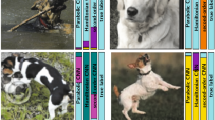Abstract
This paper addresses the understanding and characterization of residual networks (ResNet), which are among the state-of-the-art deep learning architectures for a variety of supervised learning problems. We focus on the mapping component of ResNets, which map the embedding space toward a new unknown space where the prediction or classification can be stated according to linear criteria. We show that this mapping component can be regarded as the numerical implementation of continuous flows of diffeomorphisms governed by ordinary differential equations. In particular, ResNets with shared weights are fully characterized as numerical approximation of exponential diffeomorphic operators. We stress both theoretically and numerically the relevance of the enforcement of diffeomorphic properties and the importance of numerical issues to make consistent the continuous formulation and the discretized ResNet implementation. We further discuss the resulting theoretical and computational insights into ResNet architectures.






Similar content being viewed by others
Notes
F. Chollet et al. Keras, 2015. https://keras.io.
References
Arsigny, V.: Processing data in Lie groups: an algebraic approach. Application to non-linear registration and diffusion tensor MRI. Ph.D. thesis, Ecole Polytechnique (2006)
Arsigny, V., Commowick, O., Pennec, X., Ayache, N.: A log-Euclidean framework for statistics on diffeomorphisms. In: International Conference on Medical Image Computing and Computer-Assisted Intervention: MICCAI, vol. 9(Pt 1), pp. 924–931 (2006)
Ashburner, J.: A fast diffeomorphic image registration algorithm. NeuroImage 38(1), 95–113 (2007)
Avants, B., Gee, J.C.: Geodesic estimation for large deformation anatomical shape averaging and interpolation. NeuroImage 23, S139–S150 (2004)
Beg, M.F., Miller, M.I., Trouvé, A., Younes, L.: Computing large deformation metric mappings via geodesic flows of diffeomorphisms. Int. J. Comput. Vis. 61(2), 139–157 (2005)
Bietti, A., Mairal, J.: Group invariance, stability to deformations, and complexity of deep convolutional representations. J. Mach. Learn. Res. 20(25), 1–49 (2019)
Chang, B., Meng, L., Haber, E., Ruthotto, L., Begert, D., Holtham, E.: Reversible architectures for arbitrarily deep residual neural networks. In: Neural Network cs.CV (2017)
Davis, P.J., Rabinowitz, P.: Methods of Numerical Integration. Academic Press, London (1984)
Glorot, X., Bengio, Y.: Understanding the difficulty of training deep feedforward neural networks. In: AISTATS (2010)
Gomez, A.N., Ren, M., Urtasun, R., Grosse, R.B.: The reversible residual network—backpropagation without storing activations. In: NIPS (2017)
Gouk, H., Frank, E., Pfahringer, B., Cree, M.J.: Regularisation of neural networks by enforcing Lipschitz continuity. In: Neural Networks stat.ML (2018)
Haber, E., Ruthotto, L.: Stable architectures for deep neural net works. Inverse Probl. (2018). https://doi.org/10.1088/1361-6420/aa9a90
Hauser, M., Ray, A.: Principles of Riemannian geometry in neural networks. In: NIPS (2017)
He, K., Zhang, X., Ren, S., Sun, J.: Delving deep into rectifiers: surpassing human-level performance on ImageNet classification. In: IEEE ICCV (2015). https://doi.org/10.1109/ICCV.2015.123
He, K., Zhang, X., Ren, S., Sun, J.: Deep residual learning for image recognition. In: 2016 IEEE Conference on Computer Vision and Pattern Recognition (CVPR), pp. 770–778. IEEE (2016)
He, K., Zhang, X., Ren, S., Sun, J.: Identity mappings in deep residual networks. In: ECCV (2016). https://doi.org/10.1007/978-3-319-46493-0_38
Jacobsen, J.H., Smeulders, A., Oyallon, E.: i-RevNet: deep invertible networks. In: International Conference on Learning Representations (ICLR) (2018)
Kim, J., Lee, J.K., Lee, K.M.: Accurate image super-resolution using very deep convolutional networks. In: CVPR (2016)
Kim, J., Lee, J.K., Lee, K.M.: Deeply-recursive convolutional network for image super-resolution. In: CVPR (2016)
Kingma, D.P., Ba, J.: Adam: a method for stochastic optimization (2014)
Klein, A., Andersson, J., Ardekani, B.A., Ashburner, J., Avants, B., Chiang, M.C., Christensen, G.E., Collins, D.L., Gee, J., Hellier, P., Song, J.H., Jenkinson, M., Lepage, C., Rueckert, D., Thompson, P., Vercauteren, T., Woods, R.P., Mann, J.J., Parsey, R.V.: Evaluation of 14 nonlinear deformation algorithms applied to human brain MRI registration. NeuroImage 46(3), 786–802 (2009)
Krizhevsky, A., Hinton, G.: Learning multiple layers of features from tiny images. University of Toronto (2009)
Liao, Q., Poggio, T.A.: Bridging the gaps between residual learning, recurrent neural networks and visual cortex. In: Neural Networks (2016)
Mallat, S.: Understanding deep convolutional networks. Philos. Trans. R. Soc. A Math. Phys. Eng. Sci. 374(20), 20150203-16 (2016)
Ruthotto, L., Haber, E.: Deep neural networks motivated by partial differential equations (2018)
Scholkopf, B., Smola, A.J.: Learning with kernels. Support Vector Machines, Regularization, Optimization, and Beyond. MIT Press, Cambridge (2002). https://mitpress.mit.edu/books/learning-kernels
Sotiras, A., Davatzikos, C., Paragios, N.: Deformable medical image registration: a survey. IEEE Trans. Med. Imaging 32(7), 1153–1190 (2013)
Szegedy, C., Zaremba, W., Sutskever, I., Bruna, J., Erhan, D., Goodfellow, I., Fergus, R.: Intriguing properties of neural networks. In: ICLR (2014)
Thirion, J.: Image matching as a diffusion process: an analogy with Maxwell’s demons. Med. Image Anal. 2(3), 243–260 (1998)
Trouvé, A.: Diffeomorphisms groups and pattern matching in image analysis. Int. J. Comput. Vis. 28(3), 213–221 (1998)
Weinan, E.: A proposal on machine learning via dynamical systems. Commun. Math. Stat. 5(1), 1–11 (2017)
Xie, S., Girshick, R.B., Dollár, P., Tu, Z., He, K.: Aggregated residual transformations for deep neural networks. In: CVPR, pp. 5987–5995 (2017)
Younes, L.: Shapes and diffeomorphisms. Applied Mathematical Sciences, vol. 171. Springer, Berlin (2010)
Younes, L.: Diffeomorphic learning (2018)
Acknowledgements
We thank B. Chapron and C. Herzet for their comments and suggestions. The research leading to these results has been supported by the ANR MAIA Project, Grant ANR-15-CE23-0009 of the French National Research Agency, INSERM and Institut Mines Télécom Atlantique (Chaire “Imagerie médicale en thérapie interventionnelle”) and Fondation pour la Recherche Médicale (FRM Grant DIC20161236453), Labex Cominlabs (Grant SEACS), CNES (Grant OSTST-MANATEE) and Microsoft trough AI-for-Earth EU Oceans Grant (AI4Ocean). We also gratefully acknowledge the support of NVIDIA Corporation with the donation of the Titan Xp GPU used for this research.
Author information
Authors and Affiliations
Corresponding author
Additional information
Publisher's Note
Springer Nature remains neutral with regard to jurisdictional claims in published maps and institutional affiliations.
Rights and permissions
About this article
Cite this article
Rousseau, F., Drumetz, L. & Fablet, R. Residual Networks as Flows of Diffeomorphisms. J Math Imaging Vis 62, 365–375 (2020). https://doi.org/10.1007/s10851-019-00890-3
Received:
Accepted:
Published:
Issue Date:
DOI: https://doi.org/10.1007/s10851-019-00890-3




